Precis of Soil Science Simplified 5th Edition
Mostly oxygen. Dirt is a structured collection of smashed rocks and plants that is quite different once you get a few feet deep.
This modest and straightforward book explains the dirt on top in a comprehensive and approachable manner, only sometimes drifting into dull and job-specific methods, reference manuals, and basic arithmetical conventions. It has about one mind-blowing fact every 15 pages, which is not bad, and makes it much easier to understand contentious soil issues of the contemporary moment, such as erosion, desertification, microflora, corn yields, urban sprawl, population growth, the weather in America, and kids eating dirt.
Materials Science for Dirt
The crust is 20 to 30 miles thick, and is almost all oxygen and silicon.

Soil forms by: physical weathering, mineral transformations, dissolution, leaching of soluble materials, and erosion of soil particles. So, to think about early soil formation, the basic rock types (igneous, sedimentary, and metamorphic) are important.
Weathering over geological time destroys most rocks fast, but quartz (igneous) is very resistant and is therefore abundant (most sand is quartz). Some conditions support more weathering than others. An area that gets wet then dry, or where soil is warmer in general, will weather rocks faster. Soils that have not yet faced much weathering tend to be richer in Gypsum and soluble salts. Older soils that experience more warmth and rainfall contain relatively more rocks resistant to weathering, such as hematite, zircon, and garnet.
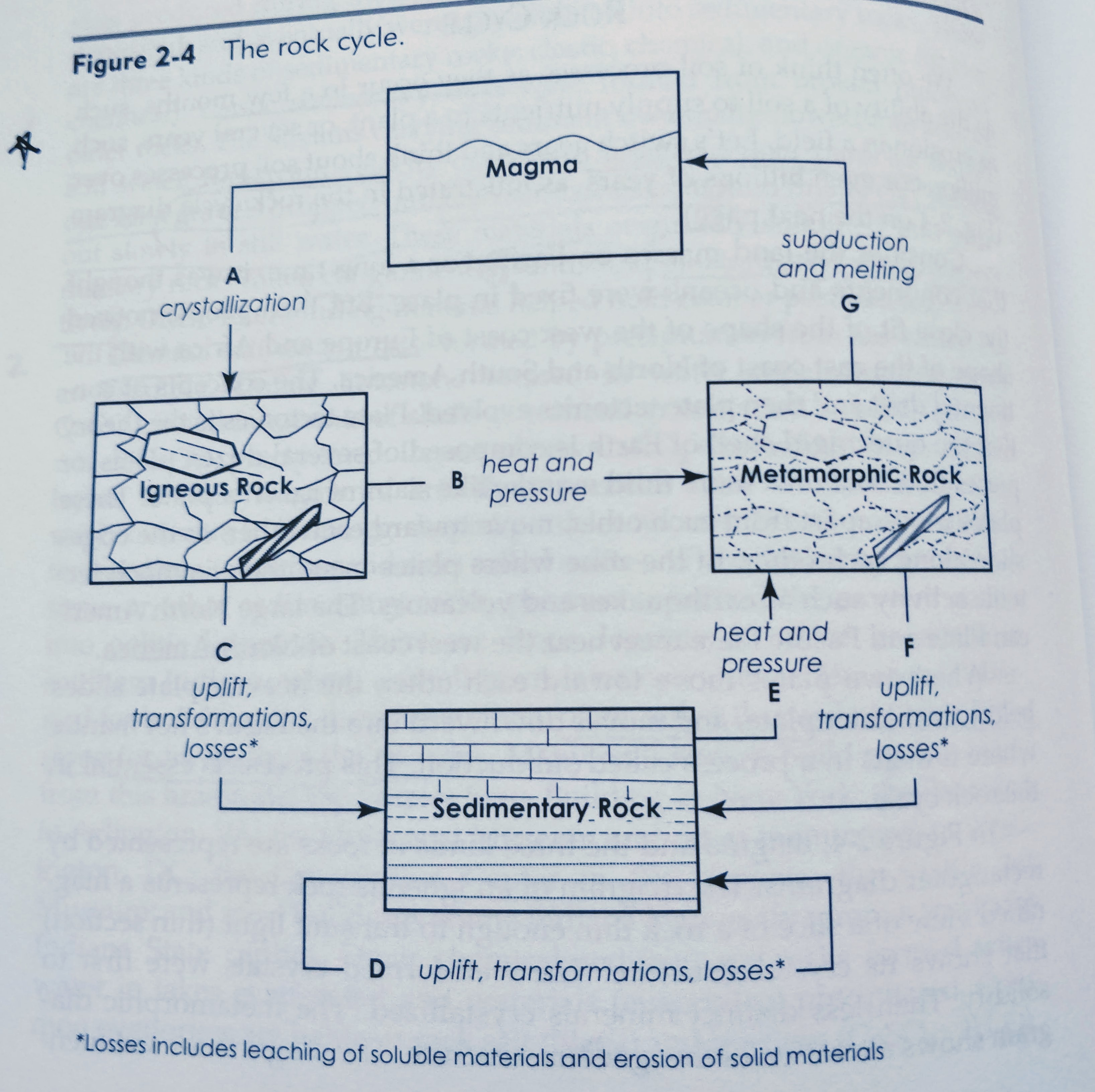
Though it isn?t presented as very significant, color of soil has a few major causes. Most soil minerals are colorless or light grey. Organic matter (?humus?) adds black or dark brown color, and the more of it the darker the soil will be. Red and yellow usually comes from iron oxide (Goethite, rust, or hematite have different shades within this range). So if there is no iron oxide or organic matter in the soil, it will be gray, which is mostly going to be silicate minerals. A mottled pattern can arise from poor drainage, which causes oxides only to form during part of the year. Those are the rules of thumb for all soil ever. Pretty cool.
Clay, Silt, and Sand
You can think of soil as a combination of three types of particles (smashed rocks): clay, silt, and sand.
Clay is by far the smallest. The biggest clay particle is .002 mm in diameter. It can remain in solution indefinitely. It tends to drain down into the ground with erosion, forming clay skins after heavy rains. It also holds water the best, because its small size affords it a higher surface area per volume. Water is good at grabbing onto surfaces, so more surface area to volume means more water retention. Funny, right.
Slightly bigger, silt is carried off easily by wind and water. Silt is the ?dust? you face in a dust storm.
Sand is a bunch of rock fragments. Both silt and sand are fairly inert, chemically. The good thing about sand is that it keeps the soil loose, making space for water and air to circulate.
The best soils are called ?loam? and are 10?20% clay, with equal parts sand and silt. More clay than that, and the soil is pretty much just clay.
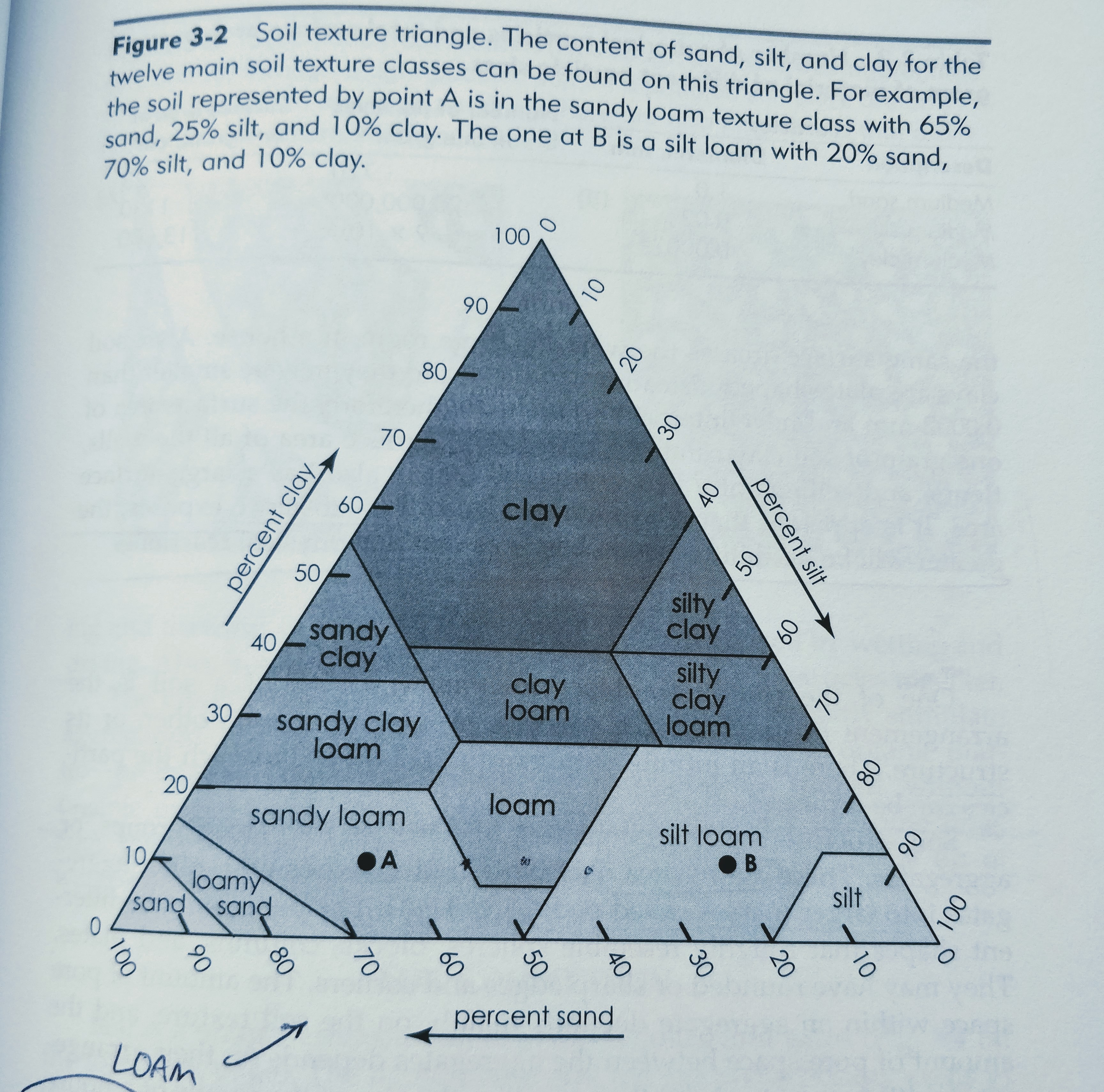 This is such a dope diagram. I didn?t even realize you could make a triangle diagram like this.
This is such a dope diagram. I didn?t even realize you could make a triangle diagram like this.
You can tell relative content of these particle types with a cool field test! Moisten a small sample of the soil, and work it between your fingers. Sand feels gritty, silt floury, and clay sticky. If the soil is mostly clay, knead it and then try to squeeze out a ribbon shape. The longer the ribbon, the more clay in the soil. Science!
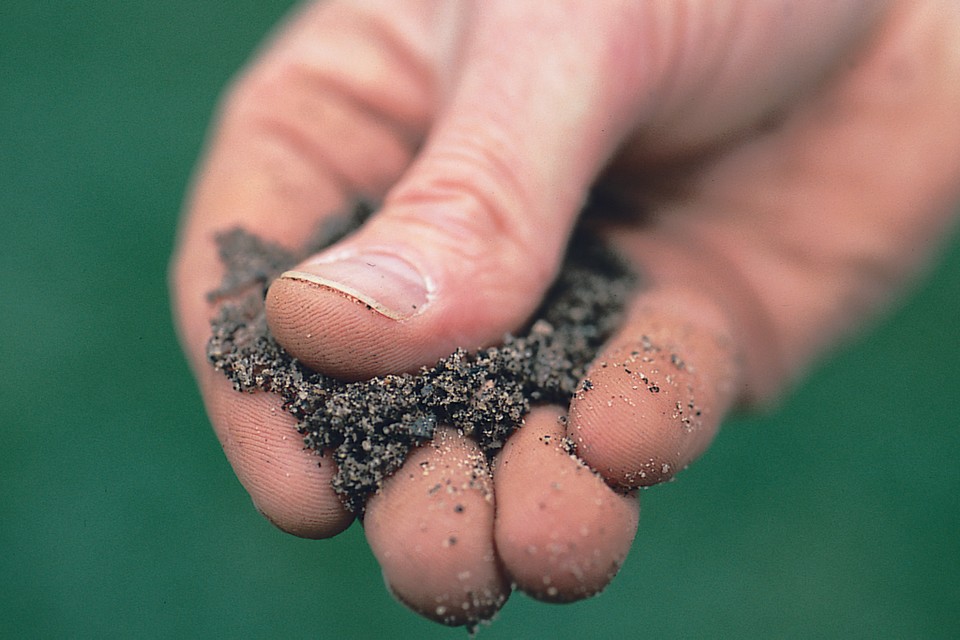 Last time I tried this, a sharp pebble cut my middle finger.
Last time I tried this, a sharp pebble cut my middle finger.
Structure
Soil has internal structure. It forms small aggregates (dirt clods?) that are bound into larger masses called peds which can be examined through larger (1?2m diameter) units called pedons. The aggregates are stronger when organic matter, such as plant roots, support them. Clay helps too. If there is no organic matter, they are quite vulnerable to water and, if submerged, will lose their structure. (This is basically what happens if you have a potted plant with no drainage! Then the plant can?t get air or water really and it dies.)

If you get soil wet and run it over with heavy machines (a normal part of farming in America for a while), it loses this structure and is considered ?puddled? or in poor ?tilth.? (What a great word! You can improve tilth with tilling!) This puddled structure is also called ?massive.?
The goal is a medium ?textured? soil with good aggregates. This would have about 50% pore space and the pores could ultimately hold as much water as air. Plants would like this.
Soil porosity is quite interesting on its own because small pores (less than .06mm diameter) draw water up from the water table by capillary action, while larger pores let water drain down. Both are useful, especially when considering air flow. So the ideal here is 1:1 big to small pores.
You can calculate the percent porosity of a soil by determining density of its solid particles (often equal to quartz!) and bulk density (dry weight over volume at a specific moisture condition). A good result here is about 50% porosity. There are lots of little formulas like this in soil science that match against ideal soil conditions for growing various plants.
Soil swelling can also be determined by related techniques and mostly matters for supporting structures, such as roads and fences, that sit on top of soil. Again, clay is the key and high clay content means more swelling. One particularly notable form of swelling is gilgai relief, which forms in soils that have minerals that swell and shrink considerably creating compactions and rarefactions over cycles of swelling and drying.
 Gilgai relief mostly looks like puddles. But remember ? this fucker swells and shrinks dramatically. That?s why it?s got those pot holes.
Gilgai relief mostly looks like puddles. But remember ? this fucker swells and shrinks dramatically. That?s why it?s got those pot holes.
Soil temperature year round varies mostly by local temperature, how moist it is in which months (which depends largely on soil color), and whether it?s exposed to the sun or covered with other things (such as plants).
Mud and So Forth
Ok, but soil moisture isn?t just about puddling or drying out. A field has a minimum amount of moisture it holds, which is basically limited by water table, clay, and organic material. That?s called ?permanent wilting point.? It has a couple maxima, which are the saturated point (which no one cares about because it?s so temporary), then, after water percolates out in a couple days, the ?field capacity.? The good stuff is the range between field capacity and permanent wilting point. Here, soil should crumble easily between the fingers (?friable?) and can be worked without getting puddled.
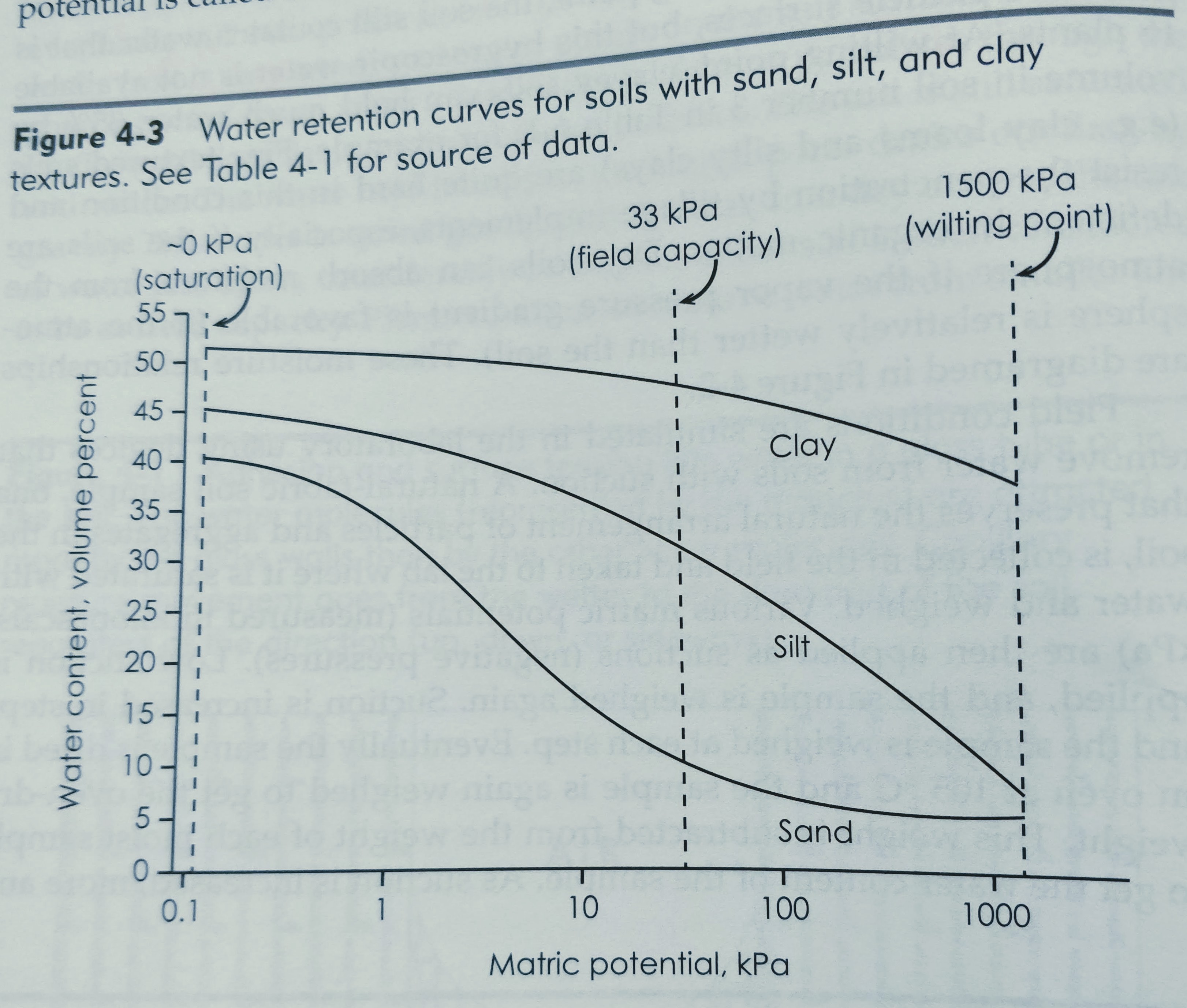
Now plants use a lot of water. Generally, they use 200?1000 lbs of water to form 1lb of dry plant matter. Corn requires 20?25 inches of rain. Plants want to suck in water throughout their life cycle, but naturally get more in the rainy season, which often correlates with temperature by season. When it?s too wet, farmers can use drainage lines (about three feet underground) to remove some moisture. But the water should drain itself usually, though there may be an underground layer preventing this such as a ?tractor pan? which is a compacted zone created by farm equipment oops.
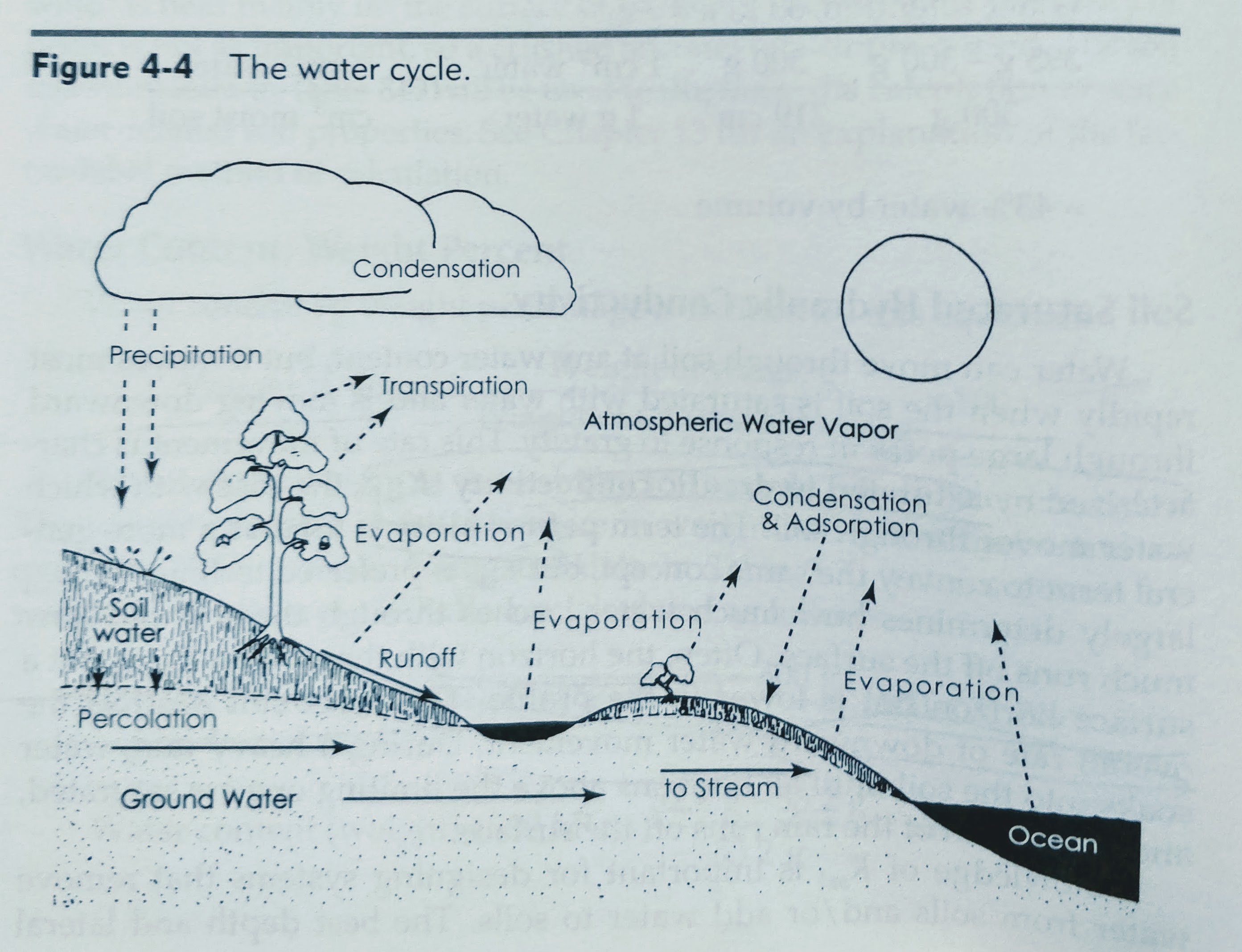
Ok all these big picture factors come down to a Thorntwaite water balance diagram. Surprising right? But it really is what you wanted your whole life and never realized. It shows you the dry spell and how long it will last and makes a stark contrast between different locations where temperature and rainfall make growing conditions great or awful. Or just boggy: if the soil won?t drain or otherwise prevents decomposers from thriving, organic matter can just build up by as much as a foot per thousand years. (Maximum recorded depth in the US is 32 feet.) This book has so many nice vocab words, it mentions that organic matter with no decay is ?peat,? but with partial decay is merely ?muck.?
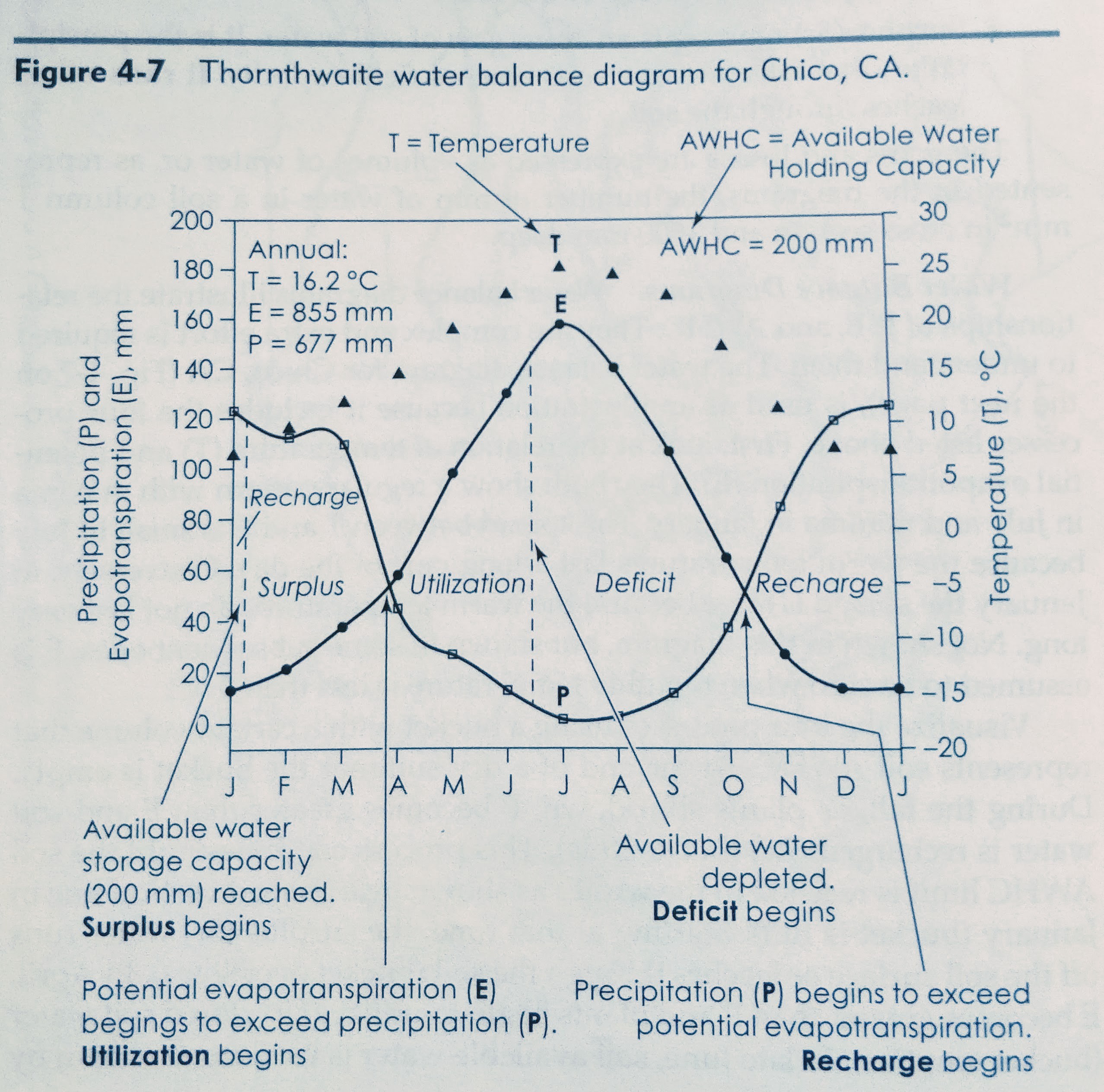
In this diagram of water in Chico, CA you can see the average temperature per month up and down with seasons (the triangles), plus a very clear depression in precipitation rate from April to October (the P line). Potential evapotranspiration comes to a maximum in summer, when there is hardly any precipitation and thus no water to evaporate! So, even though a field can store some water within it, this is going to get used up really quickly starting in the late spring and early summer, where the rate of evapotranspiration rises fast and precipitation falls fast. The whole field is going to get really dry and stay that way without getting better at all until October!
Anyway, you can imagine they irrigate a lot out there.
Soil in America
Soil formation has a lot to do with climate, and the soil?s condition continues to change depending on climate and vegetation. This book has a number of amazing maps illustrating regional variation in the US.
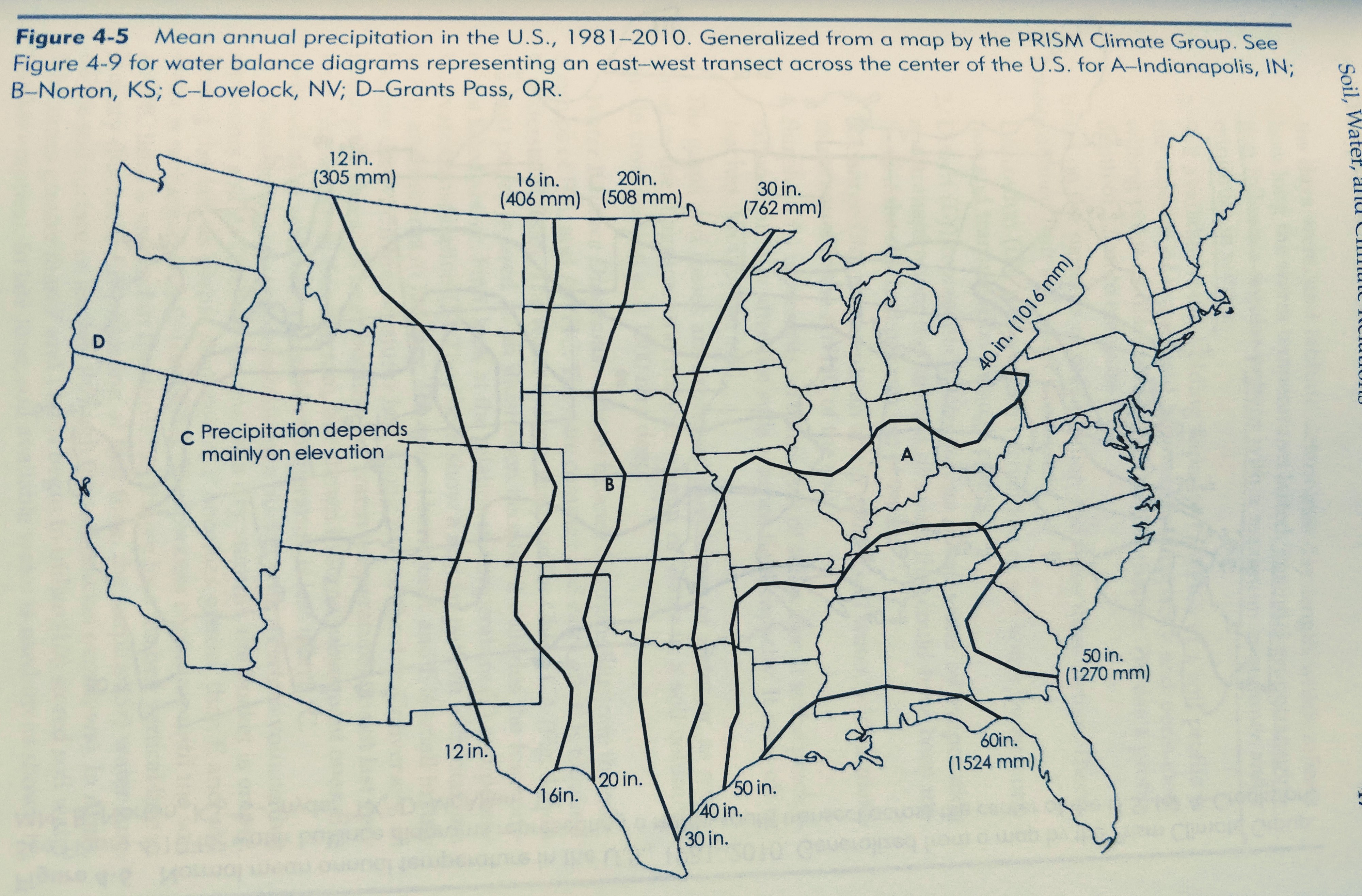
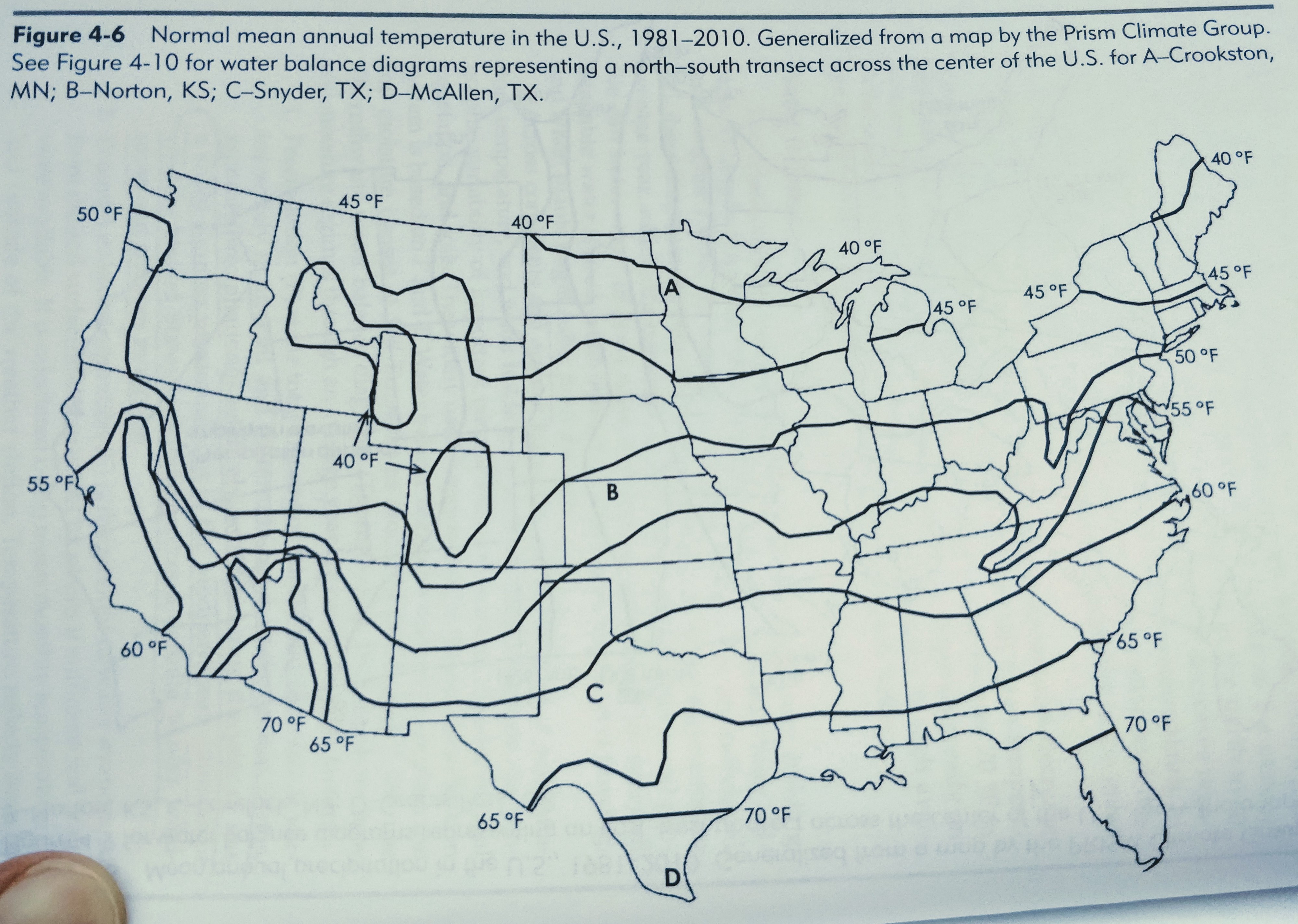
The book goes into great depth with those Thorntwaite diagrams to explain why growing conditions are like they are in different regions, and what practices are used to compensate for them. I?m skipping this because it went from cool regional trends to very specific zones of soil within small towns. You?ve got to care about the specific soil to work it, really. Which is strange, given a central claim of the book: soil is the working capital of the farmer.
Critters
Over time, microbial ecosystems flourish in some soils, and these are extremely important for agriculture. The carrying capacity of a pasture, for example, is roughly equal to the weight of microbes in its soil!
Microbes decompose organic matter, slowly releasing nutrients locked up in them. They also add to soil structure by excreting a gelatinous magic called ?glomalin.? Bacteria, especially Rhizombium capture nitrogen (plentiful in the air) in the soil, fertilizing plants.
In addition to microbes, various small animals in the soil help improve its condition by digging holes, eating things, and shitting everywhere. Earthworms get a lot of respect, but one study in the 1960s suggested that ants can completely renew the surface inch of a forest soil in 250 years. The range and proportion of mechanisms here is not fully clear, but it sounds like critters in the dirt help add structure and prevent puddling, while also cycling around what?s in there and probably contributing some nutrients. I wonder if they are also deleterious to the soil, or any are known soil ruiners. Anyway, if they are they can?t be that quick about it, or everyone would know.
Farm Dirt
?Over the next 50 years, the world?s farmers and ranchers will be called upon to produce more food than has been produced in the past 10,000 years combined, and to do so in environmentally sustainable ways.?Norman Bourlag, 2009
There?s no explanation here, but the book asserts that hydroponics and aquaculture are not going to be anywhere near sufficient to feed the growing human population of earth. So we?re going to be relying on the soil, and trying to get more out of it, for a long time. Soil serves to anchor roots, supplies water to the plant, provides air for the roots, furnishes minerals.
Ok, but what are the basic factors of soil science you need know to keep your farm in good shape? Soil becomes more fertile by material brought down from the rain, nitrogen fixation by microbes, decomposition of crop residues, weathering of the soil breaking up minerals, and by the addition of fertilizer or manure in reasonable quantities. Your basic threats to the good soil of a farm are: removal of crops removing nutrients, erosion, leaving , conversion of nutrient elements into unusable forms.
Across all these factors, you can put in some work and get better results, then more work and still some improvement, but you eventually face diminishing returns and should chill back before you?re seriously wasting your time.Nitrogen fertilizers have been the biggest advance out of soil science in a while, and really changed the world. The idea is that plants grow better with more nitrogen, up to a point, and you can just dump the right nitrogenous goo on them and presto they grow more. You can basically tell what crop needs more nitrogen by comparing your yield to known yields for the same strain, by looking at overall leaf color from the air, or monitoring how much nitrogen is lost with crop removal. But the final calculation is just some basic economics presented here.
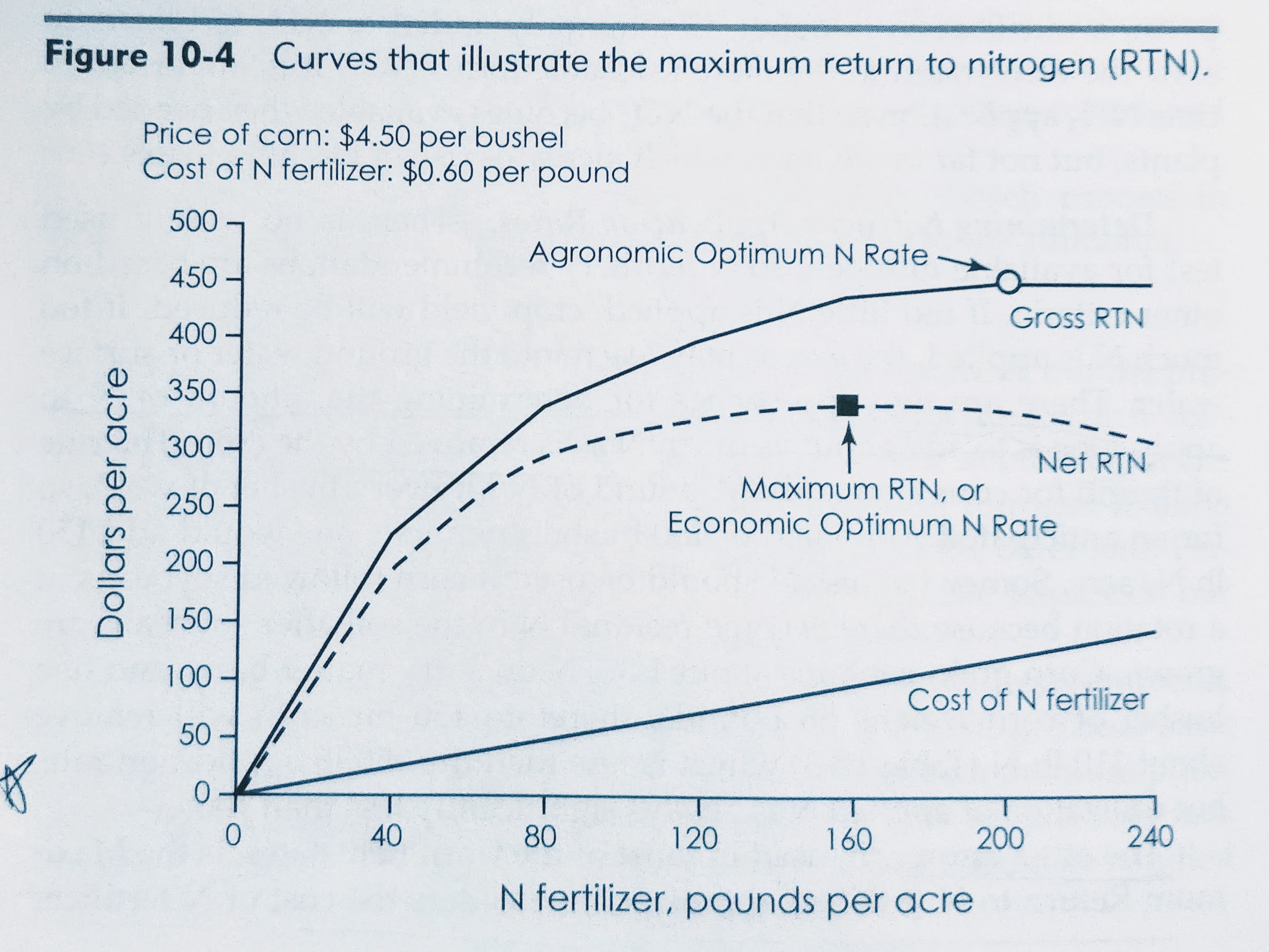
You can also fertilize with Phosphorus and Potassium or other nutrients, depending on crop needs. It?s also common to change the Ph of the soil with fertilizers ? typically powdered limestone.
Some of these only release a small portion of their total content each year, because they weather slowly. All run some risk of overfertilization, which can create salts in the soil or just drain off and cause problems for those downstream. Some of these fertilizers (Nitrogen in particular) cause soil acidification too.
Soil: Important to the Environment
Soils take a very long time to form, geologically, and tend to do well with native plants living on them. But the way that we treat soil is often quite different from this. (Often humans clear away all the old plants before doing anything else!) So there are some important risks we run with soil.
Erosion
Soil erosion is one of the largest risks. Erosion matters because the top of the soil is almost always the best part for growing. This is true because it contains more plant residue and because clay drains down a bit deeper into the soil, making the topsoil easier for roots to grow in. But the lower soil, with more clay, is better at retaining moisture, which is also good for plants with deeper roots. With enough erosion of topsoil, the more clay-rich subsoil becomes the top soil, but it does not absorb water as well, which makes it worse for plant growth and causes more erosion as water flows off of it. Ultimately, crop yields are worse on more eroded soil, so it?s all pretty straightforward for the farmer.
For a deeper perspective, it?s common for a soil to make 20,000 years to form 1m of good soil, which means natural processes yield soil at a rate fo .05mm per year. So any erosion faster than that is going to net reduce usable soil.
How does erosion happen? Soil particles can be detached from aggregates by rain on exposed earth. If there is plant matter covered the soil, this won?t happen nearly as much. Raindrops land at up to 10 or 20 miles per hour!
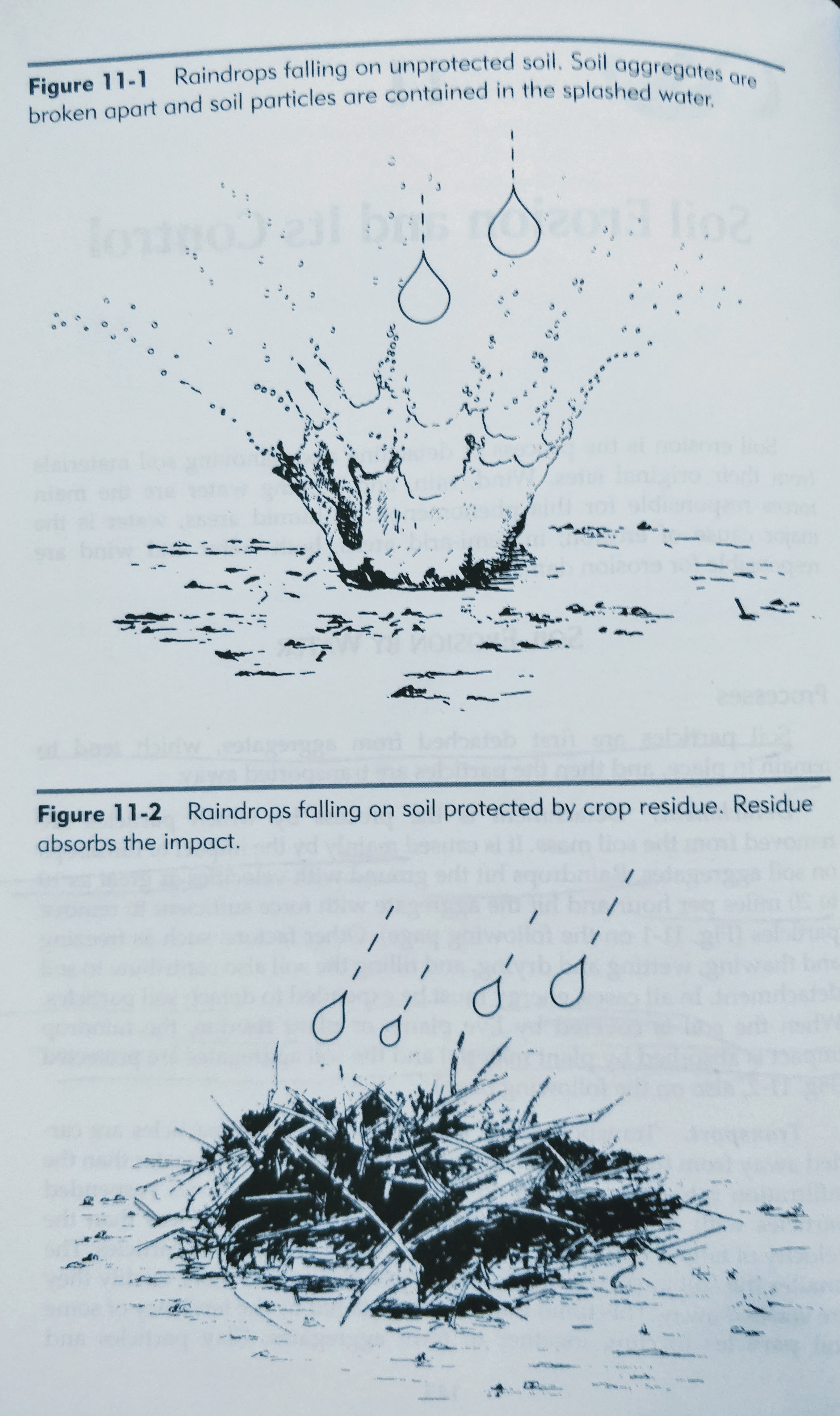 Such a clear illustration. Bare soil erodes with rain! See why?
Such a clear illustration. Bare soil erodes with rain! See why?
Water erodes soil in three ways: ? by getting it so wet there?s a thin surface of water moving dirt a long bit at a time, called ?sheet erosion? ? by cutting in small rivulets, ?rill erosion? ? by cutting in deeper gullies, more than six inches deep, that drain water and erode the soil.
The first is actually most destructive, even though it doesn?t look like much.Soil is more vulnerable to erosion if it gets very dry for part of the year, because this weakens the aggregates. It is relatively immune to erosion when it?s frozen. Also being under cement helps. More clay content and organic matter also help a soil resist erosion, because these bind aggregates.
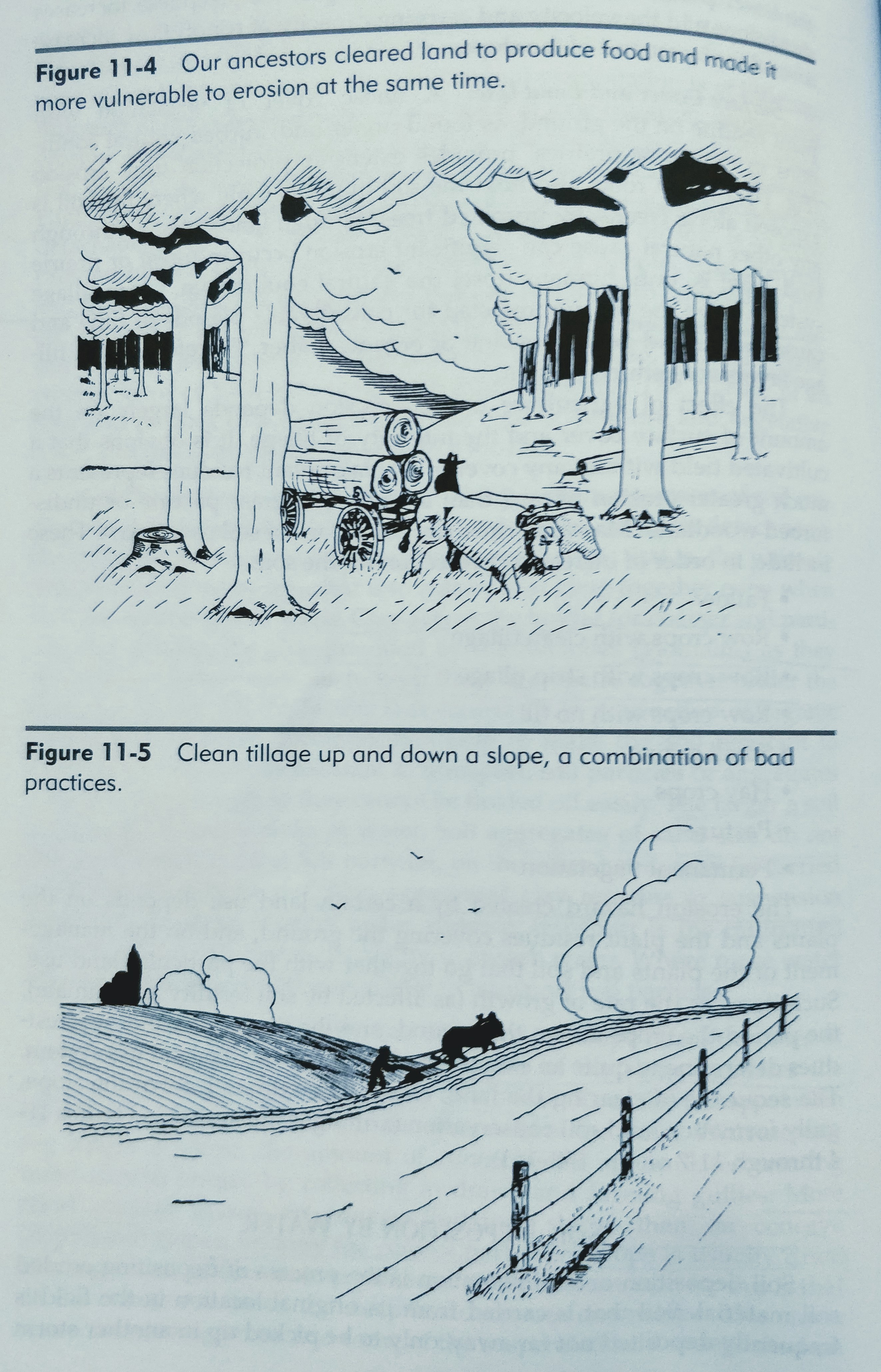 Seems legit
Seems legit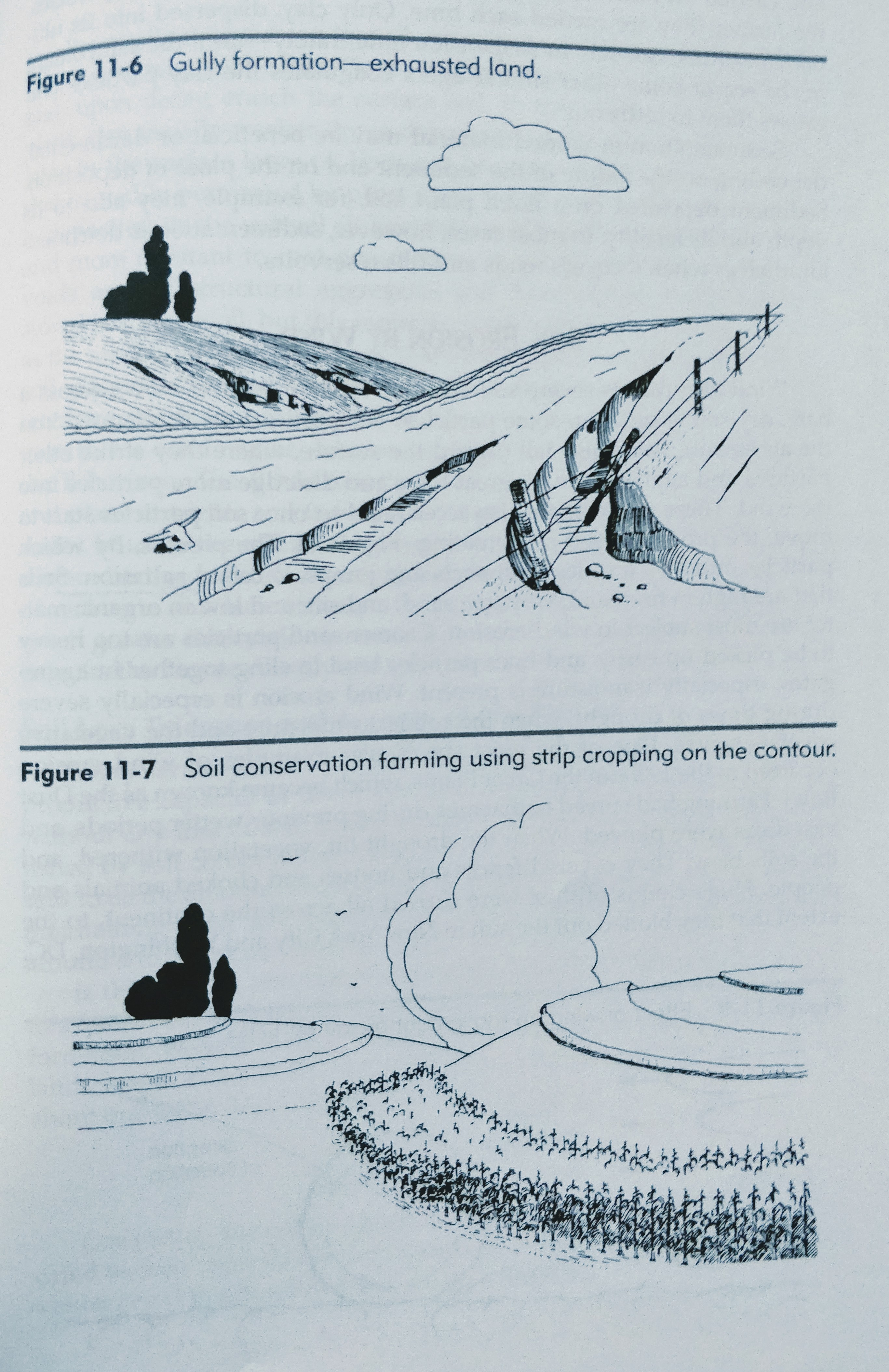 Oh, right! We should conserve our land!
Oh, right! We should conserve our land!
Since the 1980s, erosion has decreased considerably in America, due to efforts no doubt fueled by insights from soil science. On average, soil erosion is now just under the .05mm rate mentioned earlier, but there are lots of cases where erosion is still happening too quickly.
Some ways to reduce erosion: ? keep the soil covered at all times with living plants or plant residues ? add organic matter to the soil to strengthen its aggregates ? planting winter crops which can then be killed or turned under does both and can restore nitrogen to the soil and provide mulch to reduce evaporation ? don?t till the crop all the way down, just leave a few inches at the bottom
This book makes no comment about soil restoration techniques. Instead it focuses completely on conservation. It seems like this approach is sufficient, but restoring soil sure would be handy too!
Soil & The Environment
Besides erosion, why does soil matter to the environment?
It supports plants that help regulate temperature. Wetlands are just soils that are saturated with water for several months a year; wetlands replenish groundwater, retard runoff, filter sediments, and serve as an important habitat for animals. Bogs and marshes are terrific carbon sinks. (Most developed countries have ruined much of their wetlands.)
Lots of the damage that is done to soil is done by attacks on soil structure. Clean cutting off all plants exposes soil to rain, which compacts the soil and loses nutrients to runoff. Driving heavy machinery over soil compacts it.
Salinization is also a risk, since it makes it harder to grow plants. Soil can get too salty simply by cutting down trees and putting in crops. The crops don?t hold as much water as the trees did, so the water table rises and brings up salts that were previously stored rather deep in the soil. Over-irrigation can also raise the water level and bring up salts. You can also fuck this up by pumping water out of wells a lot, so that the water cycle goes into reverse and ocean water osmoses into the wells, bringing salt. Pretty crazy.
Desertification is a scary word. Realistically, this happens a lot in poor places where a draught makes the land much less productive than usual, but the people stick it out and they (and their livestock) exhaust the land by eating grasses down to the dirt and trees down to dead trunks, thus exposing the soil to erosion from wind and water. The land never recovers and you get a desert. Very common. Quite bad.
Soil contamination is a familiar worry. If you put too much manure on a field, it might not all stay there, and runoff and movement through the water table yields water high in nitrate, which is unhealthy to drink. You can build an ?ion exchange facility? (sounds awesome) to remove nitrate from water, but they cost about $10k/day to run. Phosphorus is also quite bad in the wrong place. When it runs off, it can get into bodies of water where it stimulates growth of aquatic organisms. Great, right? Actually their extra metabolism exhausts the oxygen in the water, which can ruin their ecosystem. It?s called anoxic water.
Pesticides are their own kind of problem, and DDT and chlordane are known examples of ?safe? pesticides that actually devastated the greater environment.
Straight up trash and poo can be problems too, but the issue is mostly that dumps and septic systems are often not up to code. If you build to code, these things are not much of a risk to the soil or water table. Finally, there is illegal dumping of hazardous materials, which is its own problem.
Gosh this book has so many good environmental damage scenarios that are so interesting to think about. It goes into the risk of flooding in urban areas, which is intensified by paving everything over like dummies. You can take too much water from a river or aquifer and get a classic tragedy of the commons. There are lots of water scenarios presented here.
Big picture, though, the Earth?s population is rising. The book has some really nice charts on this, pointing out that basically Africa and Asia are going to grow while Europe, North America, and Latin America level out.
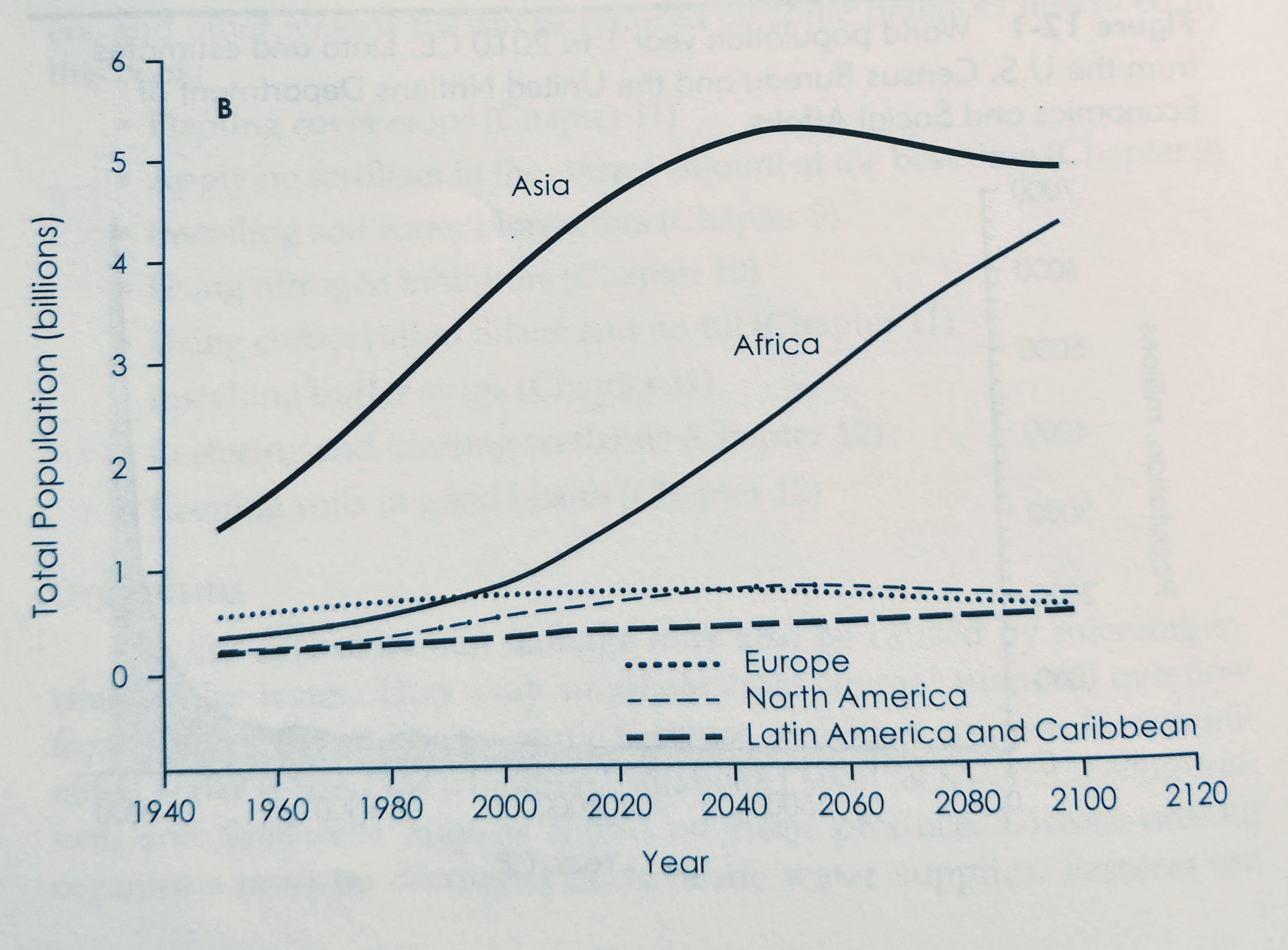 Growth will level off everywhere else, but Asia and then Africa are going to grow a lot for a long time.
Growth will level off everywhere else, but Asia and then Africa are going to grow a lot for a long time.
108 billion humans have ever lived, and we can expect to hit 2080 at between 7 and 16 billion. At the same time, land is getting destroyed (mostly erosion) fairly quickly.
The saving grace so far has been the green revolution, which used mostly breeding and fertilization to increase crop yields by about 5x. This offset decline in farmable land and increases in population, but do you want to count on this? Will we be able to increase crop yields like that again soon?
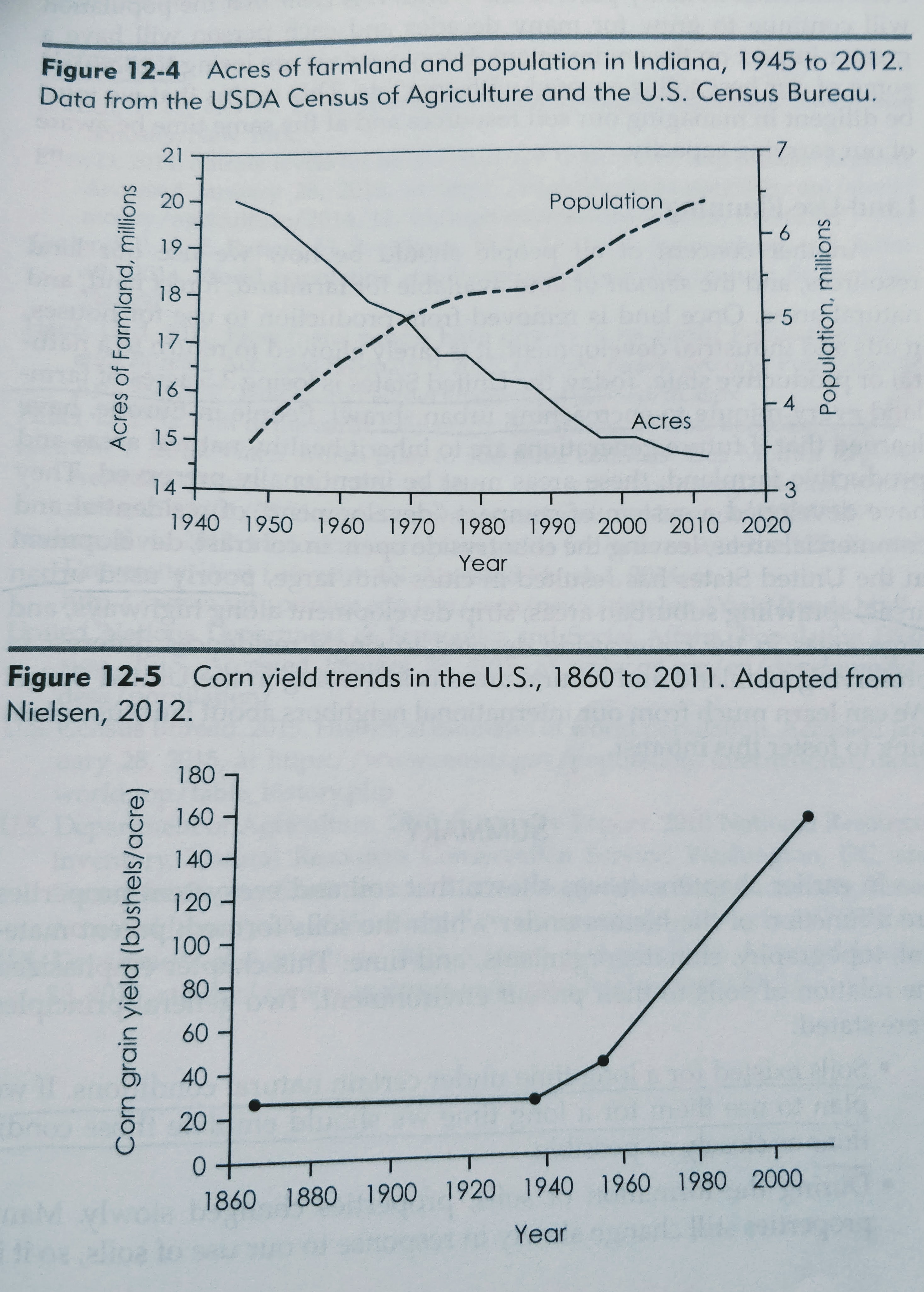 Declining acreage of farmland in Indiana alongside increasing population looks like a big problem! But we really got out of all the obvious shortsightedness of our behavior by increasing corn yields by so much. Makes me think of Julian Simon: more people means more good ideas and good human work getting done.
Declining acreage of farmland in Indiana alongside increasing population looks like a big problem! But we really got out of all the obvious shortsightedness of our behavior by increasing corn yields by so much. Makes me think of Julian Simon: more people means more good ideas and good human work getting done.
Sadly, the very last chapter of this book shows you how to convert units in the course of basic arithmetic. It?s hella basic and kind of a let down. This book is a textbook, so it?s probably good to include that shit somewhere.
Conclusion
Soil science is pretty significant if you want to think about the environment in more detail, and the material science is pretty familiar (stuff is made of smaller things, surface area and volume are important, organic chemistry determines layers and ion exchange). For example, a Medium article on the importance of sand as a resource for construction? Makes more sense when you understand soil. Iron fertilization at sea? Quite similar to fertilizer runoff! Anyway, that?s why people read textbooks. To understand issues rather than just have an emotional reaction to them. Old school, right?
I love this book?s diagrams and illustrations and really appreciate the vocabulary words, which seem to come from farmers rather than big abominations of latin roots and suffices.

